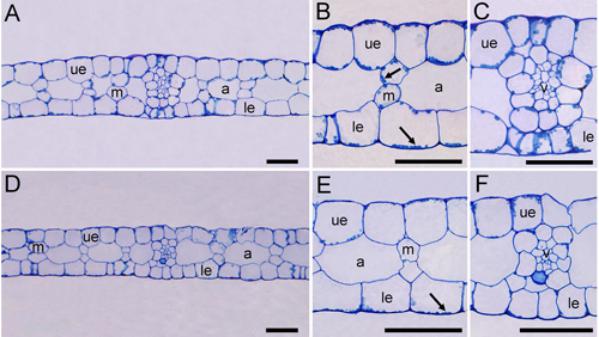Ottelia alismoides(Hydrocharitaceae) is a freshwater macrophyte which possesses three kinds of carbon dioxide-concentrating mechanisms, bicarbonate use, C4 photosynthesis and CAM (crassulacean acid metabolism). As we all known, the function is often closely associated with structure. In many terrestrial C4 plants, Kranz anatomy is an essential structure for plants performing C4 photosynthesis. However, in aquatic C4 plants, the leaf anatomy used for operating C4 metabolism in O. alismoides was still unknown.
Recently, the Aquatic Plant Biology Research Group, led by Prof. LI Wei from Key Laboratory of Aquatic Botany and Watershed Ecology, Wuhan Botanical Garden, discovered that O. alismoides performe C4 photosynthesis without Kranz anatomy.
The leaf anatomy of O. alismoides was simple and only consisted of epidermal and mesophyll cells, and big air spaces. The chloroplasts in the mesophyll and epidermis were different in leaves grown at low CO2: mesophyll chloroplasts were spherical filled with starch, while epidermal chloroplasts were spindle with less starch.
This study clarified sufficient structural diversity within the leaf of O. alismoides to support dual-cell C4 photosynthesis even though Kranz anatomy was absent. The epidermal cells with chloroplasts maximized the uptake of external CO2, aided by bicarbonate use, while the mesophyll cells containing more starch in the chloroplasts might be the sites where CO2 was concentrated by decarboxylation. Abundant discrete air spaces provided buoyancy might also trap (photo)-respiratory CO2, or CO2 produced by decarboxylation, permitting its refixation. Whatever, further studies are still needed to confirm definitively whether O. alismoides has dual-cell C4 with the mesophyll cells representing the site of decarboxylation.
Research was funded by the Strategic Priority Research Program of the Chinese Academy of Sciences, Chinese Academy of Sciences President's International Fellowship Initiative to S.C.M. and B.G., and the National Natural Science Foundation of China. The results have been published in Annals of Botany entitled “Structural basis for C4 photosynthesis without Kranz anatomy in leaves of the submerged freshwater plantOttelia alismoides”

Transverse sections of Ottelia alismoides leaves acclimated to high and low CO2 concentrations (Image by HAN Shijuan)




